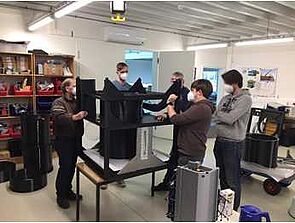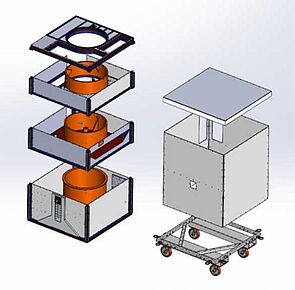ZIM
ZIM stands for Zentrale Innovationsprogramm Mittelstand (ZIM), which means “Central Innovation Programme for small and medium-sized enterprises (SMEs)”. It is a funding program of the Federal Ministry for Economic Affairs and Energy that aims to foster the innovative capacity of SMEs.
ZIM funds innovative companies, which want to develop new or significantly improved existing products, processes, or technical services. The program is open to all sectors and fields of technology. Funded projects must be highly innovative, market-oriented, and entail substantial technological risk.
Goal of MoLiCu
Development of an innovative mobile, thermally and mechanically stable “Mobile LIDAR Cube” for applications in the weather and climate analysis. The project focuses on the industrial standardization and improvement of the 3D-printed housing, which will contain an independently operating LIDAR system (with a volume under 1 m³) in the future.
Cooperation partners
1. DETHLOFF & LANGE GmbH (DeLa)
2. Leibniz-Instituts für Atmosphärenphysik e.V. an der Universität Rostock (IAP)
Funding and time period
Funded by the Federal Ministry for Economic Affairs - BMWi
Time period 01/01/2021-07/03/2022


Taks of MoLiCu
IAP succeeded in the last years to minimize the optoelectronic components for the operational LIDAR. The existing device was reduced from a container size to a volume of 1 m³ and 300 kg weight. The project will realize a prototype of the required housing for the LIDAR and set up the basis for an industrial production.
Major work packages of MoLiCu
- Redevelopment of the MoLiCu: Improvement of the static and thermal container properties
- Optimization of clean room properties by modification of construction materials
- Volume optimization for the components included, with regard to the deployment of standard electronic components and thermal stability
- Higher thermal isolation, redevelopment of measuring openings, efficient temperature zone regulation
- Improved telescope construction for measurements by day; reduction of turbulence from solar radiation
- Redevelopment of utilized 3D printing technology to decrease production time
- Development of an optimized prototype based on an industrial production process with improved properties
- Conceptual design for service and maintenance of the MoLiCu
Background information about LIDAR technology
LIDAR technology is an established measurement method for the exploration of the atmosphere (up to 100 km altitude).
By means of precise spectral measurements of Doppler-Rayleigh, Doppler-Mie, and Doppler resonance scattering temperatures, wind velocities, particle concentrations, and molecular abundances can be analyzed. In addition, different parameters that are relevant for the understanding of the atmosphere can be determined (e.g. aerosols). LIDAR diagnostic is a fundamental method for the observation and understanding of the atmosphere and the proceeding climate change.
Common LIDAR measurements require large technological efforts relating to infrastructure and resources. LIDAR cubes enable locally and temporally flexible operations to analyze current atmospheric and climate-related scientific questions.












